![]()
The Trans-Siberian Railway extended 4,700 miles from the Ural Mountains to the Sea of
Japan. From Cheliabinsk, just east of the Urals, it passed through Omsk, Krasnoyarsk, and
Irkutsk, then skirted Lake Baikal and proceeded to Chita. Shortly beyond Chita two
branches continued to the sea at Vladivostok, the chief port of the Russian Far East.
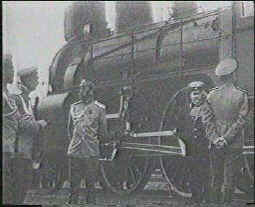 Tsar Alexander III conceived of the railroad in the late
19th century, and construction on several sections took place simultaneously.
Tsar Alexander III conceived of the railroad in the late
19th century, and construction on several sections took place simultaneously.
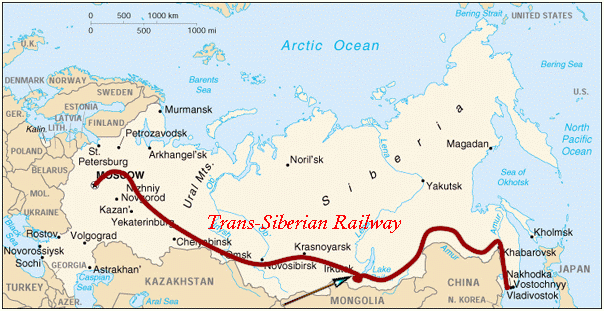
The Chinese Eastern Railway, the shorter southern branch, intersected the Chinese frontier at Manchuria Station, crossed Northern Manchuria through Harbin, the line's center for administration, and reached the Russian frontier again at Podgranitsa, a few hours from Vladivostok. The other, more circuitous branch made a great loop along the northern side of the Amur River to Khabarovsk and then due south to Vladivostok.
History of Trans-Siberian railroad (streaming RealVideo)
Trans-Siberian railway construction was
held in difficult climate conditions. Most of the road was build through low
populated or not populated areas with tense forests. The road goes across many
strong Siberian rivers, meets many lakes, swampy and permafrost areas n its way (from Kuenga to Bochkarevo, now Belogorsk). The most difficult for
builders was the section around the Baikal (Baikal station - Mysovaya station).
Here they had to blast rocks, to make tunnels, to build additional structures on
the rivers that go into Baikal.
Trans-Siberian railway building required big capital
expenditures. According to the Railway Construction Committee calculations
estimated costs of road building were 350 millions of gold rubles. Therefore, to
lower the costs and to build the road faster Committee established special
simplified technical conditions base for the Ussuriysk and Western Siberia
sections of the road. For example, according to the Committee's recommendation
the width of the earth bed in such places as mounds and excavations was
decreased, ballast layer was made thinner, lighter rails were used, the number
of sleepers for 1 km was decreased, etc. Major construction works were planed
only for the big bridges. Smaller bridges were built of wood. 50-verst distance
between stations was allowed.
he
sharpest problem was the problem of attracting labor for the building of
Trans-Siberian railway. The need for qualified workers was satisfied by hiring
workers in the center and by transporting them to Siberia. According to V.F.
Borzunov in different years in construction of different sections of the railway
were involved the following number of people. Western Siberian - from 3600 to
15000 workers form European Russia, Zabaylalskaya section - from 2500 to 4500,
Middle Siberian - from 3000 to 11000. Most of the builders were convicts and
soldiers. Peasants from Siberia, people from Siberian towns and also peasants
and low middle class people from European part of Russia were involved in
construction of Trans-Siberian railway as well. At the beginning of construction
in 1891 total number of workers on Trans-Siberian railway was 9600. In 1895 -
1896 it went up to 84000 - 89000 workers. On the final stage of construction in
1904, there were only 5300 workers. In the Amurskaya section construction works
in 1910 was involved about 20000 workers.
The use of Siberian exile for punishment of criminals and political offenders began almost immediately after the conquest, but accelerated with the rise of the Russian revolutionary movement in the 19th century.
 |
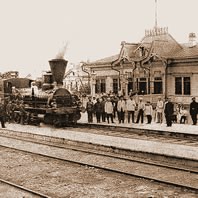 |
 |
The Trans-Siberian Railway greatly influenced the composition and size of the population of Siberia.
After the railroad’s completion in the early 1900s, Russian people migrated to Siberia in much larger numbers than before, greatly increasing Russian presence in the region.
![]() Transsiberian
railway. RealVideo
Transsiberian
railway. RealVideo
![]() Inside
the train at Transsiberian railway,download .mov 468kb
Inside
the train at Transsiberian railway,download .mov 468kb
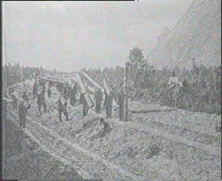 |
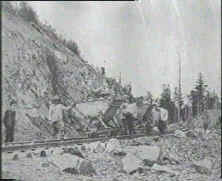 |
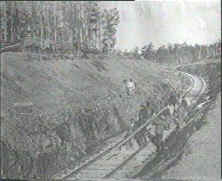 |
Here are some good links to other Transsibsites:
Trans-Sib now in Irkutsk 
![]() Fedor Babanine ( webmaster@icc.ru
)
06/25/03
Fedor Babanine ( webmaster@icc.ru
)
06/25/03